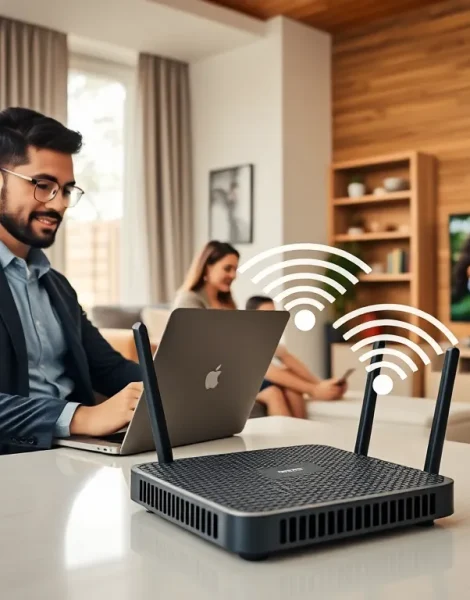In today’s digital age, having a reliable home network isn’t just a luxury: it’s a necessity. Imagine streaming your favorite Netflix series only to be interrupted by a buffering wheel that seems more like a cruel joke than a technical hiccup. With multiple devices, smartphones, tablets, and those quirky smart assistants, vying for attention, it’s crucial to ensure a seamless home networking setup. Jump into our comprehensive guide to discover everything you need to know to get your network running smoother than butter on a hot pancake.
Table of Contents
ToggleWhat Is Home Networking?

Home networking involves connecting various devices, computers, printers, smart TVs, and even security systems, within a residential environment using either wired or wireless technology. Think of it as creating a digital neighborhood where each device can communicate efficiently. This functionality transforms your living space into a tech-savvy haven, enabling you to share resources and access the internet from anywhere in your home. Whether it’s a cozy apartment or a sprawling mansion, a robust home network is vital for managing modern devices and ensuring smooth communication between them.
Importance of Home Networking Solutions
Home networking solutions carry significant importance in the daily functioning of a household. They provide seamless connectivity for remote work, online gaming, and streaming. In the realm of remote work, a solid network reduces disruptions during virtual meetings and file transfers, adding to productivity levels. Similarly, in households with multiple enthusiasts for streaming or gaming, efficient bandwidth becomes crucial. Also, as the number of smart home devices increases, think smart lights, thermostats, and cameras, strong networking becomes essential for security and functionality. The ability to control, monitor, and interact with these devices creates a convenient and intelligent environment.
Types of Home Networking Services
When exploring home networking services, one encounters various types tailored to specific needs. Here’s a quick rundown:
- Wired Networking: This method uses Ethernet cables, providing stable connections perfect for high-bandwidth activities like gaming.
- Wireless Networking: Wi-Fi networks allow several devices to connect without wires, ideal for households with mobility needs. Most gadgets connect to the internet via this method.
- Mesh Networking: A mesh network comprises multiple nodes that work together to cover large areas, eliminating dead zones and maintaining strong Wi-Fi throughout the home.
- Powerline Networking: This innovative solution uses electrical wiring to transmit data, making it useful where Wi-Fi signals struggle.
Each of these services comes with its unique advantages and can cater to different preferences and requirements.
Setting Up Your Home Network
Setting up a home network may sound daunting, but with a few crucial steps, it becomes a straightforward task. Start by determining the type of network you want, based on household needs. Gather your networking equipment, router, modem, and any cables required.
- Position Your Router Wisely: Place your router in a central location to ensure optimal signal distribution across the home. Avoid corner placements.
- Connect to the Modem: If using a separate modem, connect it to your router using an Ethernet cable.
- Power Up: Ensure the power is connected, and turn on both your modem and router. Wait for them to sync.
- Configure Settings: Access the router’s settings through a web browser to customize Wi-Fi names (SSIDs), passwords, and security settings.
- Connect Devices: Begin connecting devices using Wi-Fi or Ethernet, checking for connection quality.
Taking these steps will pave the way for a robust and efficient network.
Common Home Networking Issues and Solutions
Even the most well-planned home networks can face issues. A few common problems and their solutions include:
- Weak Wi-Fi Signal: Consider repositioning your router or investing in a Wi-Fi extender or mesh network: both can significantly improve coverage.
- Slow Internet Speeds: Sometimes, too many devices are hogging the bandwidth. To mitigate this, prioritize devices used for streaming and gaming, or upgrade your internet package.
- Connection Drops: This can occur due to interference from microwaves or other electronic devices. Switching your router to a 5GHz band might alleviate interference.
- Device Compatibility Issues: Ensure that all devices are up to date with firmware and compatible with the network standards to prevent connectivity problems.
Identifying and addressing these issues promptly can save many tech headaches.
Choosing the Right Home Networking Service Provider
Selecting a home networking service provider can feel overwhelming given the myriad of options available. Here are several factors to consider:
- Coverage Area: Ensure the provider offers robust coverage in your area, especially if you reside in a rural setting where options might be limited.
- Speed Options: Check the internet speeds offered and compare them against your needs. High-speed plans are a must for gaming or streaming in HD.
- Reliability: Read reviews and customer testimonials to gauge reliability and support quality.
- Equipment: Some providers offer modem and router rentals as part of the package. Understand if you can use your devices or if you’ll need theirs.
The right provider will seamlessly integrate into your lifestyle and provide reliable service.









